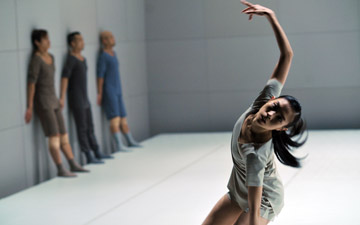
© Brian Slater. (Click image for larger version)
ACE Dance and Music
Skin Reimagined: Blind Trip, Letlalo
★★✰✰✰
London, The Place
12 November 2019
acedanceandmusic.com
www.theplace.org.uk
I was looking forward to this double bill from the Birmingham-based dance hub, ACE Dance and Music – not Arts Council England but African Cultural Exchange; a case of ACE funded by ACE – but my enjoyment was seriously and serially interrupted by that burgeoning scourge of live performance, the ubiquitous small rectangle screen of light from a mobile phone in the hands of the person in the adjoining seat. She wasn’t just checking WhatsApp or the time (although she might have had good reason to do the latter during the overlong opener) but filming the performance, oblivious to the consequent irritation that was being caused to her near-neighbours in the audience.
This is becoming a major problem and some theatres are doing little to combat it. The Place does not have an announcement prior to performances, which is a mistake. Not making a statement implies that filming is acceptable. The issue came into sharper focus on Sunday last when a man was assaulted in the foyer of the London Coliseum by another for asking the latter’s female companion to turn off her mobile ‘phone. While the assault was being perpetrated – and it was a serious incident with the complainant being knocked to the floor – the lady of said mobile was screaming “he touched my arm”! On this prior evening at The Place, I touched my neighbour’s arm to try to stop her from filming. “There but for the grace of God” springs to mind!
Now, if you have got this far you might be wondering what all of this has to do with ACE Dance and Music. Well, simply that the person filming clearly had some “friends or family” association with the company, sitting amongst a group of such supporters. The company certainly bears no responsibility for this transgression but the actions of one member of their supporters’ group ruined this critic’s ability to focus on the thing that mattered, namely the performance on stage as opposed to the tiny representation of those endeavours on a small screen arresting my peripheral vision.
Reading in the programme that a piece is ‘wildly explorative’ and ‘asks as many questions as it finds the answers’ is not the most encouraging introduction to a work; but this was the narrative for Blind Trip (**) by Akiko Kitamura and it was not so much a conversation of questions and answers, as it was a simultaneous chatter of unconnected voices in alien languages. There were too many ideas thrown at a work that was long and increasingly dreary. It had some elements of visual appeal (digital projections by Akihiko Kaneko and stark lighting by Jack Weir) and the group choreography peaked with vibrant, explosive sequences in which martial arts kicks punctuated street and contemporary movement. The group of seven dancers appeared to be of mixed ability in meeting the challenges of Kitamura’s eclectic choreography with strong athleticism juxtaposed against shaky moments (balances like a blancmange on an express train). The electronic music of Paris-based Japanese composer, Keiichiro Shibuya, was also challenging.
One of my first dance reviews was a double bill of works made and danced by Vincent Mantsoe. This was almost twenty years’ ago and I have seen nothing by this Zulu choreographer from then until now. Spirits are integral to releasing the full passion of Mantsoe’s dance, a dependence which is in his genes. His mother, aunts and grandmother are (or were) all Sangomas, people who are special in traditional Zulu society: a mix of priestess, diviner and healer with powers derived from being the incarnation of an ancestral spirit. In Dada Masilo’s Giselle (recently seen at Sadler’s Wells) her Queen of the Wilis was a Sangoma.
So, congratulations are due to ACE Dance and Music for bringing Mantsoe back to the UK with Letlalo (***), which means Skin in his native Sotho language. It is an ethereal ensemble work performed in lateral lines against dark light (the gloom on the stage at least diminished the effect of the mini-me reflections on the ‘phone screen next to me); and it provides an intense experience with the potential to be absorbing (and I wish that I could have been absorbed by it) and in contrast to the first piece it was danced strongly by the whole group.
Blind Trip was longer than it deserved to be and mixed too many ideas to be compact and coherent, while Letlalo left me wanting more of the performance on stage but less of the filming going on beside me. It’s a pity that my enjoyment of ACE Dance and Music, which seems like an important company with an outstanding outreach mission in Birmingham (where it was formed in 1996), was so compromised by someone, if not in their camp, then certainly a camp follower.

















You must be logged in to post a comment.